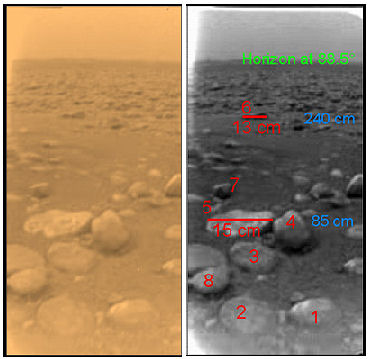Saturday, January 15, 2005
Huygens Base

15 centimeters = 5.91 inches, 8 centimeters = 3.15 inches, 4 centimeters = 1.57 inches
Again, this morning the European Space Agency presents stunning visuals of the Titanian descent and surface.
According to ESA, NASA and the University of Arizona:
The surface is darker than originally expected, consisting of a mixture of water and hydrocarbon ice. There is also evidence of erosion at the base of these objects, indicating possible fluvial activity.
The color image of the initial surface image, processed to add reflection and spectral data, is an “indication of the actual color of the surface.”
The most interesting aspect of the black and white image overlaid with measurement data, to me, is the closeness of the horizon and the smaller size of the ice chunks or rocks.
The ESA is also making two sound files available to the public.
The sound of Titanian winds during the probe's descent is most dramatic.

The 360 degree view around the Huygens probe, again according to ESA, NASA and the University of Arizona shows:
A boundary between light and dark areas. The white streaks seen near this boundary could be ground 'fog' of methane or ethane vapour, as they were not immediately visible from higher altitudes. As the probe descended, it drifted over a plateau (center of image) and was heading towards its landing site in a dark area (right). This dark area is possibly a drainage channel which might still contain liquid material. From the drift of the probe, the wind speed has been estimated at around 6-7 metres (19.68 to 22.96 feet) per second. These images were taken from an altitude of about 8 kilometres (4.97 miles).
Images: ESA

